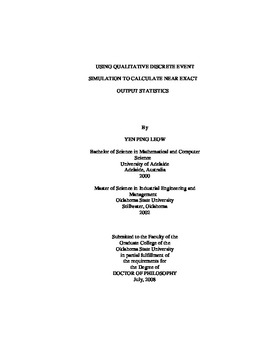| dc.contributor.advisor | Ingalls, Ricki Gene | |
| dc.contributor.author | Leow, Yen Ping | |
| dc.date.accessioned | 2013-12-10T18:05:04Z | |
| dc.date.available | 2013-12-10T18:05:04Z | |
| dc.date.issued | 2008-07 | |
| dc.identifier.uri | https://hdl.handle.net/11244/7773 | |
| dc.description.abstract | Scope and Method of Study: | |
| dc.description.abstract | The scope of this dissertation is to develop a statistical analysis method for the Qualitative Discrete Event Simulation (QDES) methodology. The method presented shows the calculation of the probability of occurrence and the event time distribution for each event that is generated using QDES by imposing an assumption on the distribution of the delay intervals in the simulation, in particularly uniform distribution. The resulting calculations are used in calculating the simulation time-persistent output statistics and tally statistics for variables of interests. | |
| dc.description.abstract | Findings and Conclusions: | |
| dc.description.abstract | The Qualitative Discrete Event Simulation (QDES) methodology has been advanced as a decision tool and its capability has been enhanced to provide meaningful output information. A probabilistic approach to the statistical analysis of a QDES model has been developed. The advancement in the area of reasoning with probability to produce near exact output statistics from QDES will allow modelers to make wise decisions based on a single run, instead of sampling from multiple runs as in a regular discrete event simulation model. The near exact output statistics will be able to describe the distribution of different variables, such as the queue length, customer delay, server utilization, etc., together with information for the probability of these average values occurring for each variable and the event sequences that lead to these values. The probabilistic nature of our approach to calculating statistics from a QDES output opens up new chapter on creating a closed-form discrete event simulation output. The key behind the approach is that by imposing statistical distribution on the temporal intervals and using a complex set of conditional probabilities for the thread, the statistics in the QDES model is exactly represented. | |
| dc.format | application/pdf | |
| dc.language | en_US | |
| dc.rights | Copyright is held by the author who has granted the Oklahoma State University Library the non-exclusive right to share this material in its institutional repository. Contact Digital Library Services at lib-dls@okstate.edu or 405-744-9161 for the permission policy on the use, reproduction or distribution of this material. | |
| dc.title | Using qualitative discrete event simulation to calculate near exact output statistics | |
| dc.contributor.committeeMember | Pratt, David B. | |
| dc.contributor.committeeMember | DeYong, Camille F. | |
| dc.contributor.committeeMember | Delen, Dursun | |
| osu.filename | Leow_okstate_0664D_2853.pdf | |
| osu.accesstype | Open Access | |
| dc.type.genre | Dissertation | |
| dc.type.material | Text | |
| dc.subject.keywords | qualitative discrete event simulation | |
| dc.subject.keywords | simulation statistics | |
| dc.subject.keywords | event probability | |
| dc.subject.keywords | simulation modeling | |
| thesis.degree.discipline | Industrial Engineering and Management | |
| thesis.degree.grantor | Oklahoma State University | |
